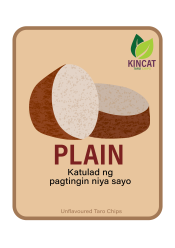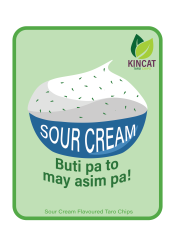| Products | Product Information |
|---|---|
Original Taro Chips 
|
It is original and plain in flavour. |
Cheese Taro Chip 
|
It is flavoured in cheese seasoning. |
BBQ Taro Chip 
|
It is seasoned in Barbeque flavour. |
Sour' n Cream Taro Chip 
|
It is seasoned in Sour & Cream flavour. |
Spicy Taro Chip 
|
It is seasoned in spicy Barbeque flavour. |
Benefits of eating Taros
1. Rich in Fiber and Other Important Nutrients
One cup (132 grams) of cooked taro has 187 calories — mostly from carbs — and fewer than one
gram each of protein and fat.
It also contains the following:
Fiber: 6.7 grams
Manganese: 30% of the daily value (DV)
Vitamin B6: 22% of the DV
Vitamin E: 19% of the DV
Potassium: 18% of the DV
Copper: 13% of the DV
Vitamin C: 11% of the DV
Phosphorus: 10% of the DV
Magnesium: 10% of the DV
Thus, taro root has good amounts of various nutrients that people often don’t get enough of,
such as fiber, potassium, magnesium and vitamins C and E.
2. May Help Control Blood Sugar
Although taro root is a starchy vegetable, it contains two types of carbohydrates that are
beneficial for blood sugar management: fiber and resistant starch.
Fiber is a carbohydrate that humans can’t digest. Since it’s not absorbed, it has no impact
on
blood sugar levels.
It also helps slow down the digestion and absorption of other carbs, preventing large blood
sugar spikes after meals.
Studies have found that high-fiber diets — containing up to 42 grams per day — can reduce
blood
sugar levels by roughly 10 mg/dl in people with type 2 diabetes.
Taro also contains a special type of starch, known as resistant starch, that humans cannot
digest and thus does not raise blood sugar levels. Roughly 12% of the starch in cooked taro
root
is resistant starch, making it one of the better sources of this nutrient. This combination
of
resistant starch and fiber makes taro root a good carb option — especially for people with
diabetes.
3. May Reduce Your Risk of Heart Disease
The fiber and resistant starch in taro root may also help reduce your risk of heart disease.
Substantial research has found that people who eat more fiber tend to have lower rates of
heart
disease.
One study found that for every additional 10 grams of fiber consumed per day, the risk of
dying
from heart disease decreased by 17%.
This is believed to be due in part to fiber’s cholesterol-lowering effects, but research is
ongoing.
Taro root contains more than 6 grams of fiber per cup (132 grams) — more than twice the
amount
found in a comparable 138-gram serving of potatoes — making it an excellent source of fiber.
Taro root also provides resistant starch, which lowers cholesterol and has been linked to a
reduced risk of heart disease.
4. May Offer Anticancer Properties
Taro root contains plant-based compounds called polyphenols that have various health
benefits,
including the potential to reduce cancer risk.
The main polyphenol found in taro root is quercetin, which also exists in large amounts in
onions, apples and tea.
Test-tube and animal studies have found that quercetin can trigger cancer cell death and
slow
the growth of several types of cancers.
It’s also a powerful antioxidant that protects your body from excessive free radical damage
that
has been linked to cancer.
One test-tube study found that taro extract was able to stop the spread of some types of
breast
and prostate cancer cells, but no human research has been conducted.
While early studies are promising, more research is needed to better understand the
anticancer
properties of taro.
5. May Help You Lose Weight
Taro root is a good source of fiber, containing 6.7 grams per cup (132 grams).
This may be because fiber slows stomach emptying, which keeps you fuller longer and reduces
the
number of calories you eat throughout the day. Over time, this may lead to weight loss.
The resistant starch in taro root may have similar effects.
One study found that men who took a supplement containing 24 grams of resistant starch
before
meals consumed roughly 6% fewer calories and had lower insulin levels after the meal,
compared
to the control group.
Animal studies have also shown that rats fed diets high in resistant starch had less total
body
fat and belly fat. It’s hypothesized that this is partially due to resistant starch
increasing
fat-burning in your body, but further research is needed.
6. Good for Your Gut
Since taro root contains plenty of fiber and resistant starch, it may be beneficial to gut
health.
Your body does not digest or absorb fiber and resistant starch, so they remain in your
intestines. When they reach your colon, they become food for the microbes in your gut and
promote the growth of good bacteria.
When your gut bacteria ferment these fibers, they create short-chain fatty acids that
nourish
the cells that line your intestines and keep them healthy and strong.
One study in pigs found that diets rich in resistant starch improved colon health by
boosting
short-chain fatty acid production and decreasing damage to colon cells (24).
Interestingly, human studies have found that people with inflammatory intestinal disorders,
such
as ulcerative colitis, tend to have lower levels of short-chain fatty acids in their guts
(25).
Some research suggests that consuming fiber and resistant starch can boost these levels and
help
protect against inflammatory bowel disease and colon cancer (26).
7. Versatile and Easy to Add to Your Diet
Taro root has a starchy texture and mild, slightly sweet taste, similar to sweet potato. It
can
be used in both sweet and savory dishes. Some popular ways to enjoy it include:
Taro chips: Thinly slice taro and bake or fry into chips.
Hawaiian poi: Steam and mash taro into a purple-hued puree.
Taro tea: Blend taro or use taro powder in boba tea for a beautiful purple drink.
Taro buns: Bake sweetened taro paste inside buttery pastry dough for dessert.
Taro cakes: Mix cooked taro with seasonings and pan fry until crispy.
In soups and stews: Cut taro into chunks and use in brothy dishes.
It’s important to note that taro root should only be eaten cooked.
Raw taro contains proteases and oxalates that can cause a stinging or burning sensation in
your
mouth. Cooking deactivates these compounds
